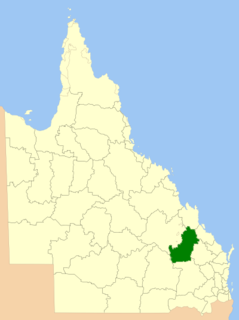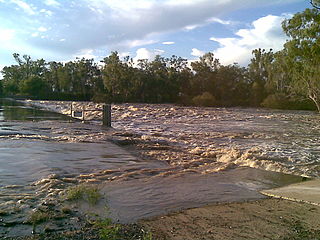
Canning Downs was the first residential establishment built by a white person on the Darling Downs in Queensland, Australia. It is located a short drive from the town of Warwick and originally extended south east to Killarney and the McPherson Range. The area was first named after the British statesman George Canning by Allan Cunningham.

Bellevue Homestead is a heritage-listed homestead currently located in Coominya, Somerset Region, Queensland, Australia. It was built from c. 1872 to c. 1910. It was added to the Queensland Heritage Register on 21 October 1992.
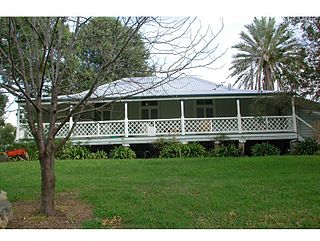
Jondaryan Homestead is a heritage-listed homestead at Evanslea Road, Jondaryan, Toowoomba Region, Queensland, Australia. It was the base of the former Jondaryan pastoral station, which was originally taken up in 1840, and at one time was the largest freehold station in Queensland. The site contains the current house, which was built after the original was destroyed by fire in 1937, the original kitchen dating from 1844, and a kitchen, butcher's shop, shearer's quarters, stables, dairy, toilet block and store, many dating from the 1860s. It also contains the remains of horse stalls, a slaughterhouse, hide store, and Chinese gardener's glasshouse. It was added to the Queensland Heritage Register on 21 October 1992.

Westbrook Homestead is a heritage-listed homestead at Coupers Road, Westbrook, Toowoomba Region, Queensland, Australia. It was built from 1864 to 1867. It was added to the Queensland Heritage Register on 21 October 1992.

Nindooinbah Homestead is a heritage-listed homestead at Nindooinbah Connection Road, Nindooinbah, Scenic Rim Region, Queensland, Australia. It was built from c. 1858 to 1907. It is also known as Nindooinbah House. It was added to the Queensland Heritage Register on 21 October 1992.

Schmidt Farmhouse & Outbuildings is a heritage-listed homestead at 3 Worongary Road, Worongary, City of Gold Coast, Queensland, Australia. It was built from 1880s to c. 1910. It was added to the Queensland Heritage Register on 8 April 1997.

Ballandean Homestead is a heritage-listed homestead at Ballandean, Southern Downs Region, Queensland, Australia. It was built from c. 1840 to 1890s circa. It was added to the Queensland Heritage Register on 21 October 1992.

Booubyjan Homestead is a heritage-listed homestead at Booubyjan Road, Booubyjan, Gympie Region, Queensland, Australia. It was built from the 1860s to the 1870s circa. It was added to the Queensland Heritage Register on 21 October 1992.

Wodonga House is a heritage-listed farmhouse at Woolooga Road, Widgee, Gympie Region, Queensland, Australia. It was built in 1902. It was added to the Queensland Heritage Register on 21 October 1992.

Glengarry Homestead is a heritage-listed homestead at Gladstone-Monto Road, Boynedale, Gladstone Region, Queensland, Australia. It was built from c. 1894 to c. 1920. It was added to the Queensland Heritage Register on 21 October 1992.
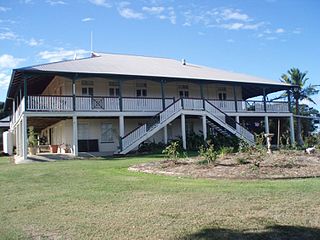
Raglan Homestead is a heritage-listed homestead at Raglan Station Road, Raglan, Gladstone Region, Queensland, Australia. It was built from c. 1857 to 1913. It is also known as Raglan Station. It was added to the Queensland Heritage Register on 21 October 1992.

Gracemere Homestead is a heritage-listed homestead at 234 Gracemere Road, Gracemere, Rockhampton Region, Queensland, Australia. It was built from 1858 to 1890s. It was added to the Queensland Heritage Register on 21 October 1992.

Strathmore Homestead is a heritage-listed homestead at Strathmore Station on Strathmore Road, Springlands, Whitsunday Region, Queensland, Australia. It was built from the 1860s onward. It is also known as Strathmore Station. It was added to the Queensland Heritage Register on 13 November 2008.
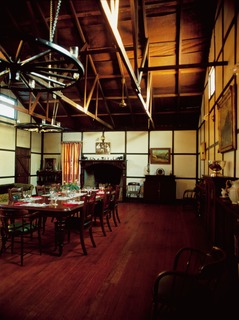
Gunnawarra Homestead is a heritage-listed homestead at Gunnawarra Road, Gunnawarra, Tablelands Region, Queensland, Australia. It was built from 1878 to 1908. It was added to the Queensland Heritage Register on 21 October 1992.

Burrandowan Station Homestead is a heritage-listed homestead at Kingaroy Road, Durong, South Burnett Region, Queensland, Australia. It was built from 1848 to c. 1927. It was added to the Queensland Heritage Register on 21 October 1992.

Eidsvold Homestead is a heritage-listed homestead at Eidsvold Road, Eidsvold, North Burnett Region, Queensland, Australia. It was built in 1850. It was added to the Queensland Heritage Register on 21 October 1992.
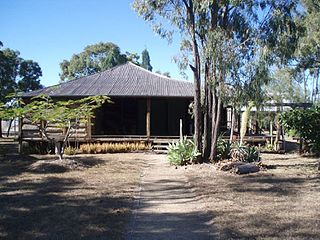
Greycliffe Homestead is a heritage-listed homestead at 48 Gladstone Road, Biloela, Shire of Banana, Queensland, Australia. It was built from c. 1863 onwards. It was added to the Queensland Heritage Register on 21 October 1992.

Tarong Homestead is a heritage-listed homestead at Cooyar Road, Tarong, South Burnett Region, Queensland, Australia. It was built from 1840s circa to 1890s circa. It was added to the Queensland Heritage Register on 21 October 1992.

Boondooma Homestead is a heritage-listed homestead at Mundubbera - Durong Road, Boondooma, South Burnett Region, Queensland, Australia. It was built from the 1850s to the 1870s. It was added to the Queensland Heritage Register on 21 October 1992.

The Avoca Homestead Complex is a heritage-listed former station homestead and station facilities and now catered accommodation and visitor attraction at 1122a Low Darling Road, Wentworth, in the Wentworth Shire, New South Wales, Australia. It was built between 1871 and 1879. It is also known as the Avoca Station Homestead and outbuildings. It was added to the New South Wales State Heritage Register on 8 April 2016.


